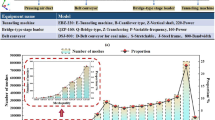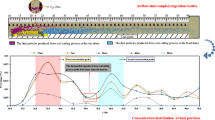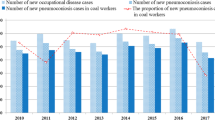Abstract
Much dust is generated in underground coal mining processes, posing threats to workers’ health and safety production. Dust enters the human body mainly through inhalation, primarily determined by the dust concentration around workers. In this study, the airflow field and dust distribution in the tunnel are simulated with FLUENT software. The breathing zone for a worker was defined to clarify the extent of external dust distribution influencing dust inhalation. The effects of human respiration, dust production rates, air supply velocities, and workers’ positions on dust concentration in the breathing zone were investigated. The results show that there is upward airflow around the worker standing in the center of the air circulation. Human breath barely influences the airflow distribution and respirable dust concentrations in the breathing zone. Reducing the dust production rate in the tunnel can decrease the respirable dust concentration in the breathing zone by almost the same proportion. While increasing the air supply velocity by 50% would reduce only 20% of dust in the breathing zone. The dust concentrations vary along the roadway, in which the low concentration zone is located in the middle, more than 1.0 m away from the dust-producing surface and the wind surface. The research contributes to reducing workers’ dust exposure with suggestions regarding ventilation optimization and working position selection.

















Similar content being viewed by others
Data availability
We guarantee that data and materials are available.
References
Alshitawi MS, Suyambazhahan S, Alaboodi AS (2019) Computational fluid dynamics simulation of breathing zone of the human for air quality with a personalized air curtain. Adv Mech Eng 11:1–13. https://doi.org/10.1177/1687814019844688
Cai P, Nie W, Chen D-W, Yang S-B, Liu Z-Q (2019) Effect of air flowrate on pollutant dispersion pattern of coal dust particles at fully mechanized mining face based on numerical simulation. Fuel 239:623–635. https://doi.org/10.1016/j.fuel.2018.11.030
Chen D, Nie W, Xiu Z-H, Yang B, Du T, Liu Q, Peng H-T (2022) Research on environmental dust pollution: ventilation and dust space-time evolution law of a fully mechanized mining face with 7m mining height. Environ Sci Pollut Res 29:33627–33644. https://doi.org/10.1007/s11356-021-17967-5
Chen Z-J, Shi J-Q, Zhang Y, Zhang J-H, Li S-Q, Guan L (2022) Screening of serum biomarkers of coal workers’ pneumoconiosis by metabolomics combined with machine learning strategy learning strategy. Int J Environ Res Public Health 19:7051. https://doi.org/10.3390/ijerph19127051
Geng F, Luo G, Wang Y-C, Peng Z-B, Hu A-Y, Zhang TT, Chai H-L (2018) Dust dispersion in a coal roadway driven by a hybrid ventilation system: a numerical study. Process Saf Environ Prot 113:388–400. https://doi.org/10.1016/j.psep.2017.11.010
Guffey SE, Flanagan ME, Belle G (2001) Air sampling at the chest and ear as representative of the breathing zone. Am Ind Hyg Assoc J 62:416–427. https://doi.org/10.1080/15298660108984643
Gui C-G, Geng F, Tang J-H, Niu H-W, Liu C, Teng H-X (2022) Spatial and temporal distribution of dust pollutants from a fully mechanized mining face under the improved air-curtain system. Adv Powder Technol 396:467–476. https://doi.org/10.1016/j.powtec.2021.11.005
Gui C-G, Geng F, Tang J-H, Niu H-W, Zhou F-B, Liu C, Hu S, Teng H-X (2020) Gas-solid two-phase flow in an underground mine with an optimized air-curtain system: a numerical study. Process Saf Environ Prot 140:137–150. https://doi.org/10.1016/j.psep.2020.04.028Get rights and content
Gupta JK, Lin C-H, Chen Q (2011) Transport of expiratory droplets in an aircraft cabin. Indoor Air 21:3–11. https://doi.org/10.1111/j.1600-0668.2010.00676.x
Hu S-Y, Liao Q, Feng G-R, Huang Y-S, Shao H (2020) Influences of ventilation velocity on dust dispersion in coal roadways. Powder Technol 360:683–694. https://doi.org/10.1016/j.powtec.2019.09.080
Hu S-Y, Gao Y, Feng G-R, Hu F, Liu C-H, Li J-H (2021) Experimental study of the dust-removal performance of a wet scrubber. Int J Coal Sci Technol 8(2):228–239. https://doi.org/10.1007/s40789-021-00410-y
Jiang J-H, Wang P-F, Pei Y, Liu R-H, Liu L-M, He Y-C (2021) Preparation and performance analysis of a coking coal dust suppressant spray. Int J Coal Sci Technol 8(5):1003–1014. https://doi.org/10.1007/s40789-021-00406-8
Li S-H, Xie B, Hu S-D, Jin H, Liu H, Tan X-Y, Zhou F-B (2019) Removal of dust produced in the roadway of coal mine using a mining dust filtration system. Adv Powder Technol 30:911–919. https://doi.org/10.1016/j.apt.2019.02.005
Lidén G, Waher J (2010) Experimental investigation of the concept of a ‘breathing zone’ using a mannequin exposed to a point source of inertial/sedimenting particles emitted with momentum. Ann Occup Hyg 54:100–116. https://doi.org/10.1093/annhyg/mep075
Liu Q, Nie W, Hua Y, Hua Y, Peng H, Liu C-Q, Wei C-H (2019) Research on tunnel ventilation systems: dust diffusion and pollution behaviour by air curtains based on CFD technology and field measurement. Build Environ 147:444–460. https://doi.org/10.1016/j.buildenv.2018.08.061
Lu X-X, Wang C-Y, Xing Y, Shen C, Shi G-Y (2021) Investigation on the dust migration behavior and safety zone in the fully mechanized mining face. Environ Sci Pollut Res 28:20375–20392. https://doi.org/10.1007/s11356-020-12050-x
Mo J-M, Yang J-L, Ma W, Chen F, Zhang S-J (2020) Numerical simulation and field experiment study on onboard dust removal technology based on airflow-dust pollution dispersion characteristics. Environ Sci Pollut Res 27:1721–1733. https://doi.org/10.1007/s11356-019-06847-8
Ojima J (2012) Gaseous contaminant distribution in the breathing zone. Ind Health 50:236–238. https://doi.org/10.2486/indhealth.MS1314
Paluchamy B, Mishra DP, Panigrahi DC (2021) Airborne respirable dust in fully mechanised underground metalliferous mines-generation, health impacts and control measures for cleaner production. J Clean Prod 296:126524. https://doi.org/10.1016/j.jclepro.2021.126524
Shekarian Y, Rahimi E, Shekarian N, Rezaee M, Pedram R (2021) An analysis of contributing mining factors in coal workers’ pneumoconiosis prevalence in the United States coal mines, 1986–2018. Int J Coal Sci Technol 8(6):1227–1237. https://doi.org/10.1007/s40789-021-00464-y
Song S-Z, Zhou G, Duan J-J, Meng Q-Z, Sun B, Wang Y-M (2021) CFD simulation of multi-phase and multi-component diffusion of air-dust-gas in a fully mechanized mining face. Environ Sci Pollut Res 28:18260–18275. https://doi.org/10.1007/s11356-020-11850-5
Trechera P, Querol X, Lah R, Johnson D, Wrana A, Williamson B, Moreno T (2022) Chemistry and particle size distribution of respirable coal dust in underground mines in Central Eastern Europe. Int J Coal Sci Technol 9(1):3. https://doi.org/10.1007/s40789-022-00468-2
Wang Y, Luo G, Geng F, Li Y-B, Li Y-L (2015) Numerical study on dust movement and dust distribution for hybrid ventilation system in a laneway of coal mine. J Loss Prev Process Ind 36:146–157. https://doi.org/10.1016/j.jlp.2015.06.003
Wang H, Nie W, Cheng W-M, Liu Q, Jin H (2018) Effects of air volume ratio parameters on air curtain dust suppression in a rock tunnel’s fully-mechanized working face. Adv Powder Technol 29:230–244. https://doi.org/10.1016/j.apt.2017.11.007
Xie Z-W, Xiao Y-M, Jiang C-X, Ren Z-L, Li X-Q, Yu K-C (2021) Numerical study on fine dust pollution characteristics under various ventilation time in metro tunnel after blasting. Build Environ 204:10811. https://doi.org/10.1016/j.buildenv.2021.108111
Yao H-F, Wang H-Y, Li Y-C, Jin L (2020) Three-dimensional spatial and temporal distributions of dust in roadway tunneling. Int J Coal Sci Technol 7:88–96. https://doi.org/10.1007/s40789-020-00302-7
Yin W-J, Zhou G, Gao D-H (2019) Simulation analysis and engineering application of distribution characteristics about multi-stage atomization field for cutting dust in fully mechanized mining face. Adv Powder Technol 30:2600–2615. https://doi.org/10.1016/j.apt.2019.08.007
Zhang H, Han W, Xu Y, Wang Z-F (2021) Analysis on the development status of coal mine dust disaster prevention technology in China. J Healthc Eng 2021:5574579. https://doi.org/10.1155/2021/5574579
Zhao Z (2023) Research on the motion equation of respirable dust in fully mechanized excavation face. Min Saf Environ Prot 50:14–18. https://doi.org/10.19835/j.issn.1008-4495.2023.01.003. (in Chinese)
Zhou G, Kong Y, Meng Q-Z, Jiang B-Y, Liu Y-W, Li G, Sun B, Wang J-L, Yan D, Li Z-H (2022) Research on dust dispersion law of fully mechanized mining faces under different inclinations and tracking closed dust control method. Sci Rep 12:16633. https://doi.org/10.1038/s41598-022-20606-9
Zhu J-T, He X-J, Wang L, Liao X-X, Teng G-P, Jing P-L (2022) Performance of N95 elastomeric respirators in high humidity and high coal dust concentration environment. Int J Min Sci Technol 32(1):215–224. https://doi.org/10.1016/j.ijmst.2021.11.007
Funding
This work was supported by the National Natural Science Foundation of China [grant number 52304266]; the Natural Science Foundation of Jiangsu Province [grant number BK20221143]; the Fundamental Research Funds for the Central Universities [grant number 2021QN1087]; and the Double-Innovation Doctor Foundation of Jiangsu Province [grant number JSSCBS20211202].
Author information
Authors and Affiliations
Contributions
All authors contributed to the study’s conception and design. Material preparation, data collection, and analysis were performed by Rongting Huang, Wanyi Chen, Yichun Tao, Shilong Yuan, Fan Geng, and Shihang Li. The first draft of the manuscript was written by Rongting Huang and Wanyi Chen. The corresponding author is Rongting Huang. All authors commented on previous versions of the manuscript. All authors read and approved the final manuscript.
Corresponding author
Ethics declarations
Ethical approval
We declare that all authors fully comply with ethical standards.
Consent to participate
All agree.
Consent for publication
All agree.
Competing interests
The authors declare no competing interests.
Additional information
Responsible Editor: Shimin Liu
Publisher's Note
Springer Nature remains neutral with regard to jurisdictional claims in published maps and institutional affiliations.
Rights and permissions
Springer Nature or its licensor (e.g. a society or other partner) holds exclusive rights to this article under a publishing agreement with the author(s) or other rightsholder(s); author self-archiving of the accepted manuscript version of this article is solely governed by the terms of such publishing agreement and applicable law.
About this article
Cite this article
Huang, R., Chen, W., Tao, Y. et al. Influence of environmental parameters on workers’ dust inhalation in underground mines. Environ Sci Pollut Res 31, 8963–8973 (2024). https://doi.org/10.1007/s11356-023-31800-1
Received:
Accepted:
Published:
Issue Date:
DOI: https://doi.org/10.1007/s11356-023-31800-1




